I use Black Kow composted cow manure to improve garden soil organically. Our shrubs and flowers are healthy and beautiful. Here is why it works for me.
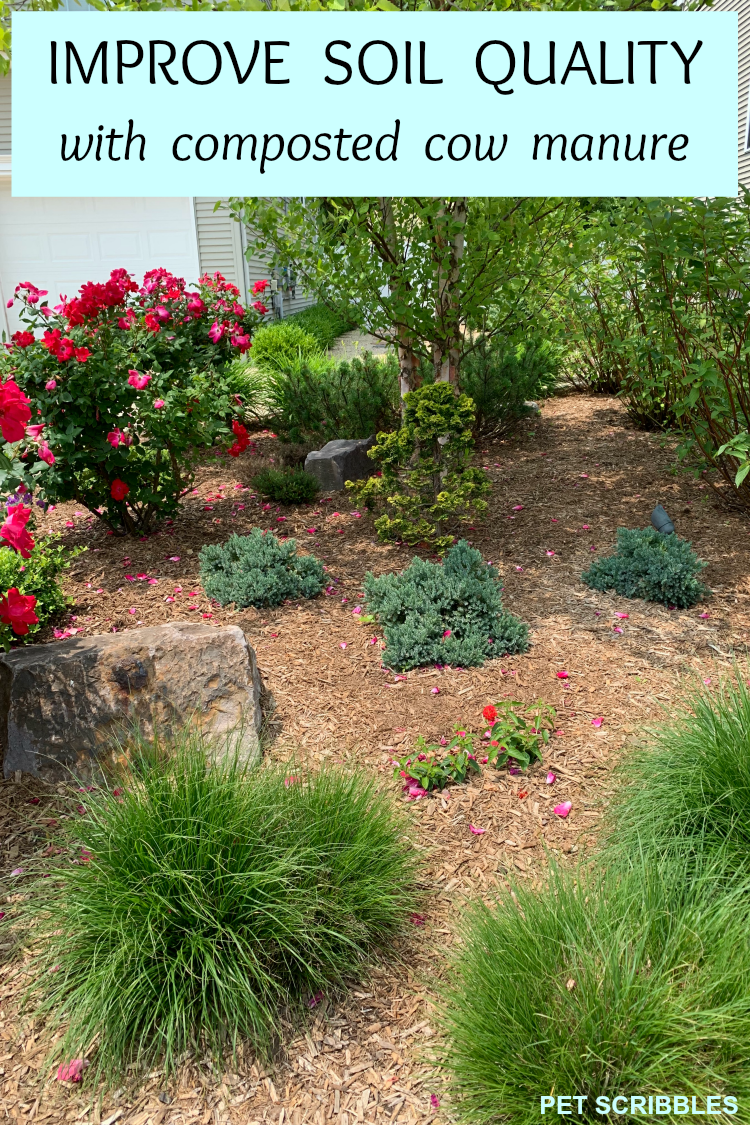
First off, this article is not sponsored in any way by Black Kow. I’m sharing my experience using their cow manure compost because our garden soil has greatly improved. Since this works for me, I hope it can work for you — and your gardens!
Table of Contents
- What does composted cow manure “do” to my garden soil?
- Can I use composted cow manure if my soil is sandy?
- Can I use composted cow manure if my soil is clay?
- Can I use fresh cow manure from a local farm?
- Black Kow composted cow manure
- Not all bagged manures are created equal
- Helpful garden tools for this project
- Not all landscapers are created equal
- Why we needed a manure and mulch weekend
- Step by step how to improve garden soil organically
- Before and after photos
- Easy maintenance step for soil improvement every year
FTC Disclaimer: Some of the links in this post are affiliate links. I explain more here.
What does composted cow manure “do” to my garden soil?
Composted cow manure contains microbes which are like teeny tiny garden soldiers. These beneficial bacteria help provide nutrients to plants and also fight bad organisms — like microscopic worms — that damage plant roots and more.
Because this cow manure has already been composted, you have all of the good stuff ready to go, without any worries you will harm your new or existing plants.
Also — composted cow manure is 100% organic, so the nutrients in this are released slowly, adding tons of organic matter to your soil. This is much better for your garden long-term, versus using a chemical fertilizer for quicker instant results.
Can I use composted cow manure if my soil is sandy?
Yes. Sandy soils usually have trouble retaining moisture where it’s needed — by the roots of your plants, trees, shrubs and flowers. Adding composted cow manure to sandy soil will help keep the moisture where you need it. Plus, by helping your sandy soil hold onto moisture, the composted cow manure also helps keep nutrients near the roots too.
Helpful tip: The healthier your soil, the less you need to water.
Can I use composted cow manure if my soil is clay?
Yes indeed, and that’s the kind of soil that I have in our garden beds. I hate clay soil. It is hard and packed and doesn’t let anything drain easily. The best way to improve clay soil is by adding organic matter that will help break the soil down so you don’t have a swampy mess. The manure helps to improve aeration, so that the water has somewhere to go and doesn’t just sit there.
Using composted cow manure will help to do this, which will greatly improve your clay soil. And just like what it can do for sandy soils, the composted manure will help provide nutrients near your plant roots.
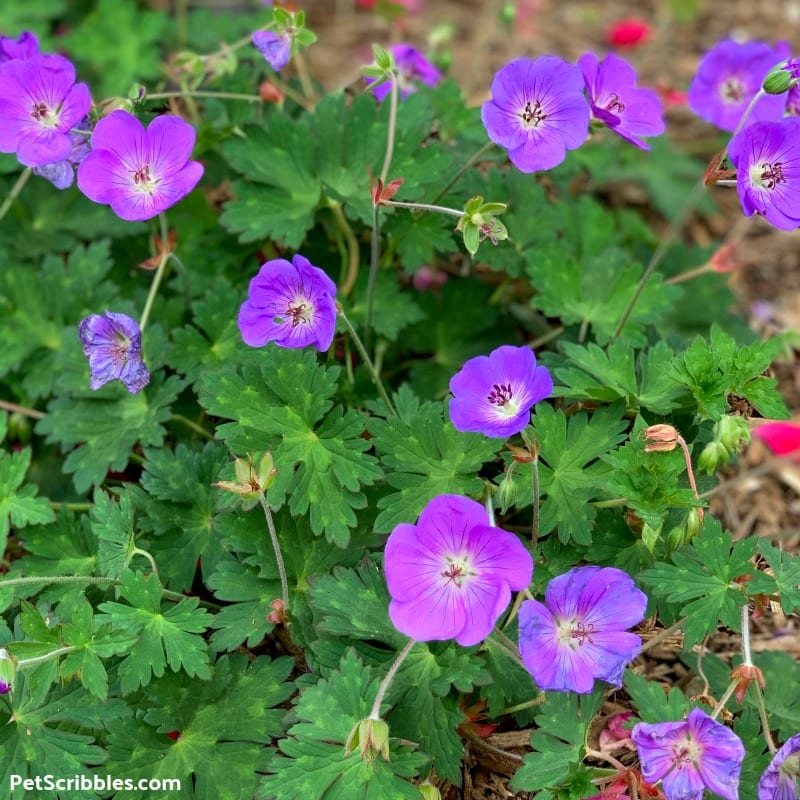
Can I use fresh cow manure from a local farm?
This is a bad idea for several reasons. First, adding fresh manure that hasn’t had a chance to be composted at all will most likely burn the roots of your garden plants from the ammonia contained in the manure. (That ammonia can also cause some plants to have bizarre growing habits that definitely aren’t normal.) Secondly, fresh cow manure often contains grass and/or weed seeds, which you definitely don’t want in your garden bed.
Fresh manure might also contain E. Coli or other dangerous bacteria, and it’s possible that fresh cow manure also contains herbicides that can harm your plants as well. I’ve read a few horror stories of this happening to gardeners.
If you’re willing to use fresh cow manure, you will need to compost it for at least a year, which takes time and effort to do it properly. (And that is a process I’m not going to cover here because… well… I’m not into unnecessary garden work.)
Black Kow composted cow manure
I use Black Kow composted cow manure in my garden beds because it has already been broken down and mixed with compost. All you have to do is mix it into your soil.
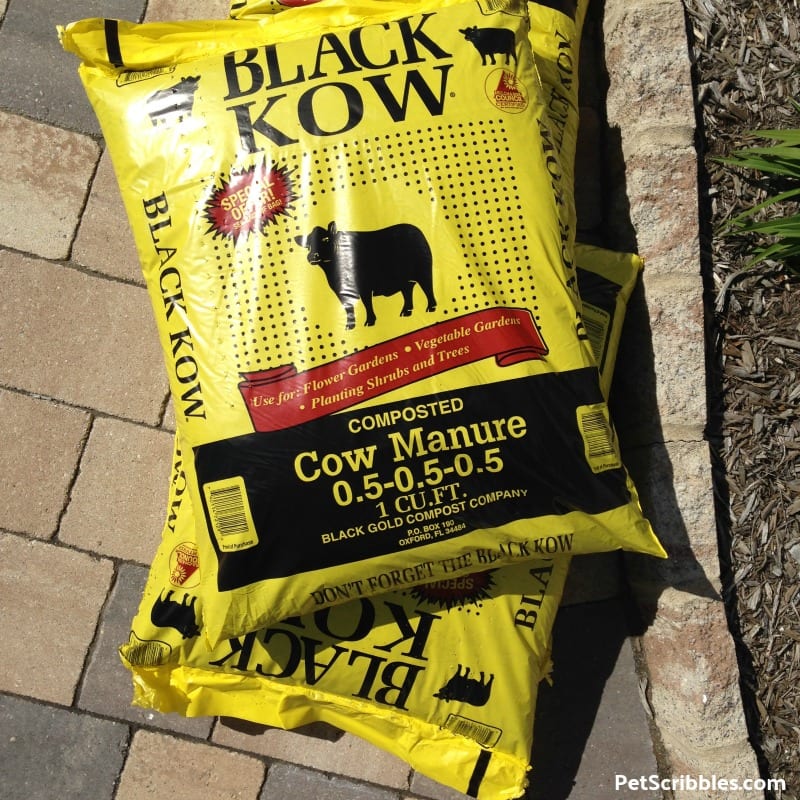
There is a bit of shoveling and mixing involved, but overall this is an easy way to improve your garden soil and make your plants, trees, shrubs and flowers happy!
Bagged Black Kow manure is available at most major garden centers and home improvement stores. (I see it’s also sold on Amazon here — BUT — it is way overpriced compared to what you will pay at a home improvement store like Home Depot or Lowe’s.)
Purchasing bagged cow manure compost is going to cost more than if you bought fresh manure directly from a farmer — but — as I mentioned earlier, this bagged manure is already mixed with compost and broken down enough to be added into your garden immediately.
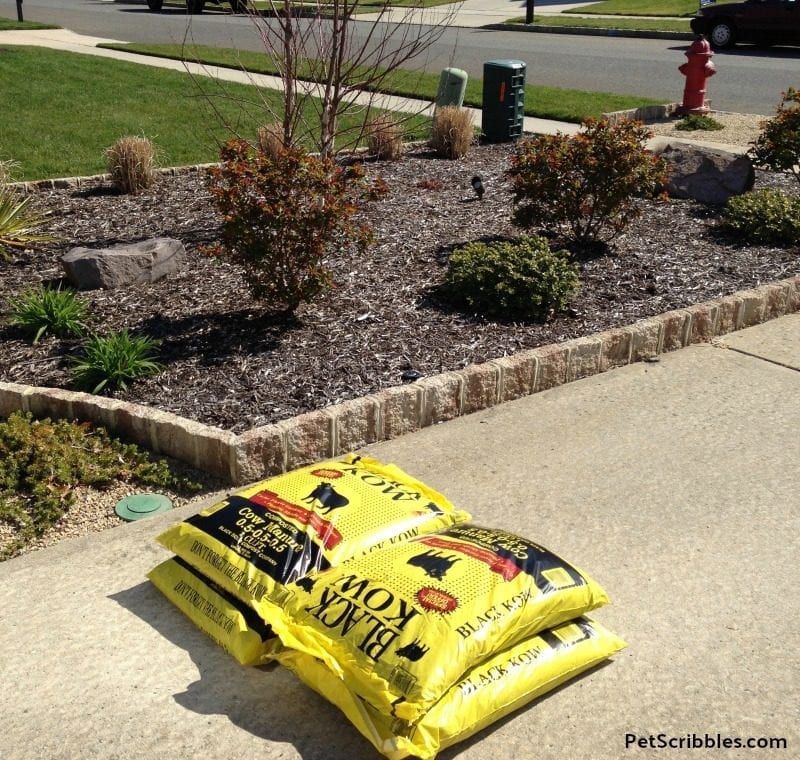
Not all bagged manures are created equal
When I’m out shopping, I like to take pictures with my iPhone of bags of soil, bags of manure, garden pest sprays, etc., so that I can easily look them up on the internet when I get home, find their company website and see what they’re about.
After I do that, I then “google” their product to see what else comes up on the internet — perhaps from other garden websites saying they’ve had success with the product or to stay far away from the product. Then I mix all of that learned knowledge inside of my brain and make a decision on purchasing or not.
And that’s what I did with Black Kow. We tried it in our garden beds and the results have been wonderful.
Helpful garden tools for this project
Gardening Gloves
If you don’t normally use gloves to do your gardening chores, I really think you should get a pair for this project. Garden gloves will make it easier to spread the cow manure compost, and make quick work of moving aside any low-hanging shrub branches that might get in your way. You can read about my favorite style of gloves here: Nitrile-Coating Gardening Gloves.
Shovel
I use my garden shovel for so many things, and this project is definitely one of them. Mine is a smaller petite shovel, which is lighter and perfect for me to easily work with. You can read about my love affair with my shovel here: Shovel Love: Being petite in the garden has its advantages!
Buckets
A great way to save money is to reuse empty buckets [from other products] for your garden chores. For years, we’ve been using several empty cat litter buckets. Recently we added an empty Preen bucket to our bucket supply.
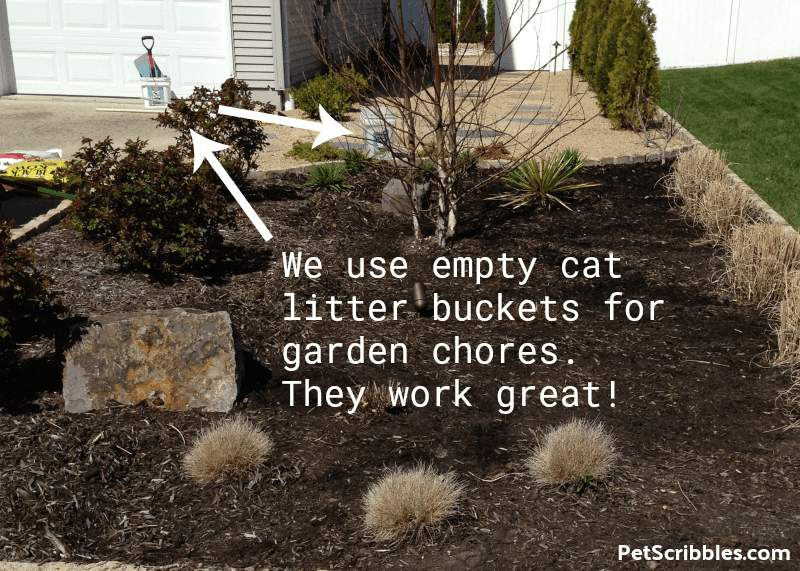
Every time I see a garden blogger post about using pretty garden buckets, I kind of shake my head. No, actually I really shake my head. Buckets will get dirty and beat up. Gardening chores aren’t meant to be pretty. Your garden — as a result of those chores — is meant to be pretty!
Rake
A basic bow rake will speed up the process of spreading garden soil and mulch. It’s also handy for spreading decorative gravel. If you want a smaller hand version, you can use a simple hand rake cultivator too.
Wheelbarrow or Garden Cart
If you’re purchasing the 50-pound bags of Black Kow, you’ll find it’s easiest to use a wheelbarrow. Put the bag into the wheelbarrow, slice open the bag and simply slide the packaging away. It will be much easier to work with the mulch. (A garden cart — which essentially serves as a smaller wheelbarrow — works too.)
Not all landscapers are created equal
When we first had our front yard landscaping completely redone, we were still relative “newbies” in terms of what hired landscapers can and do provide.
Short version? Never assume.
We assumed (hah!) that our front yard garden beds were being filled with quality garden soil. We assumed wrong.
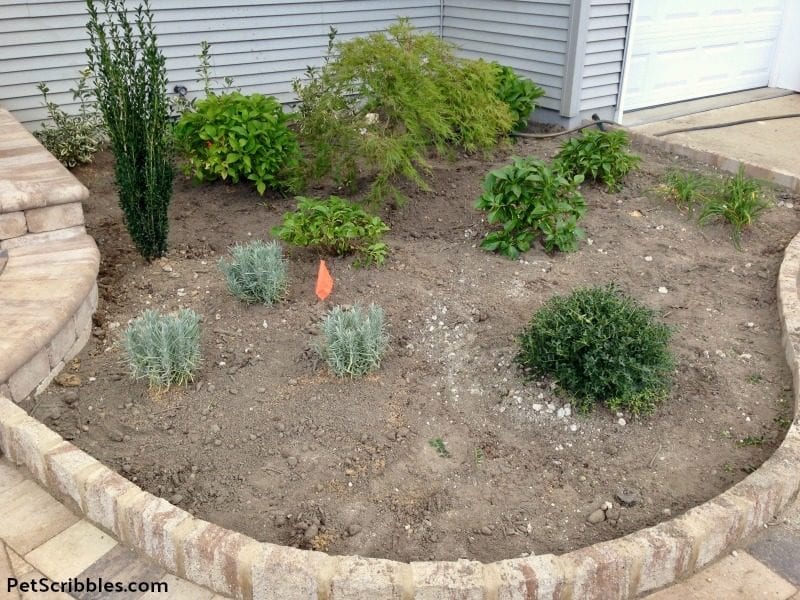
And then the landscapers covered up the soil with black mulch which looks like fresh dirt, which didn’t make us happy either. “Don’t worry, this lightens up to brown — it’s just wet right now.”
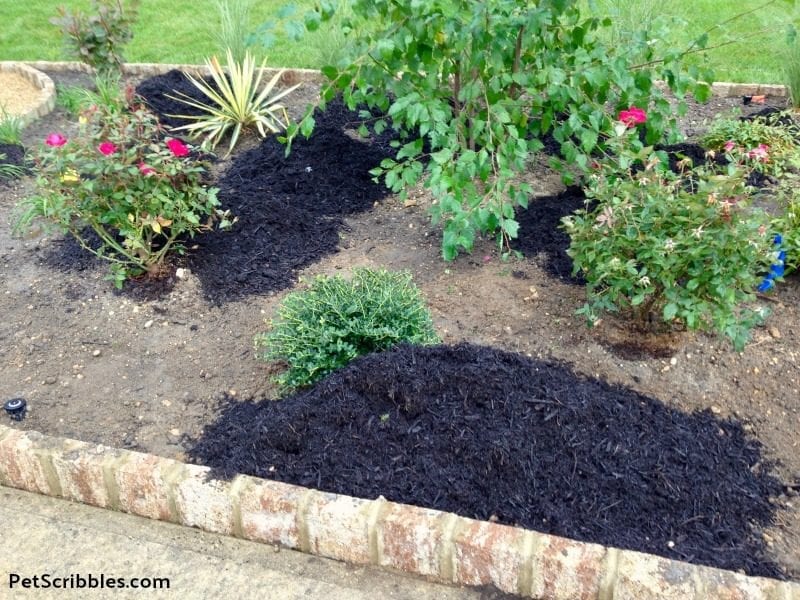
My husband and I aren’t fans of dyed black mulch because a) the black dye stained our pavers and driveway, and b) it just looked like freshly dug, wet dirt.
The black mulch also wasn’t the type of mulch we asked for, but that’s another story for another day. Short version? We’ve since moved on to a landscape company that totally gets us and understands our gardens and we love them!
Why we needed a manure and mulch weekend
That first full Spring-Summer-Fall season (2015), many of our plants seemed rather anemic and sad, including some that even appeared to be struggling.
The following Spring (2016), my husband and I decided to improve the soil ourselves, hoping this would in turn improve our plants.
We began with this garden bed (below) first, then moved on to the others:
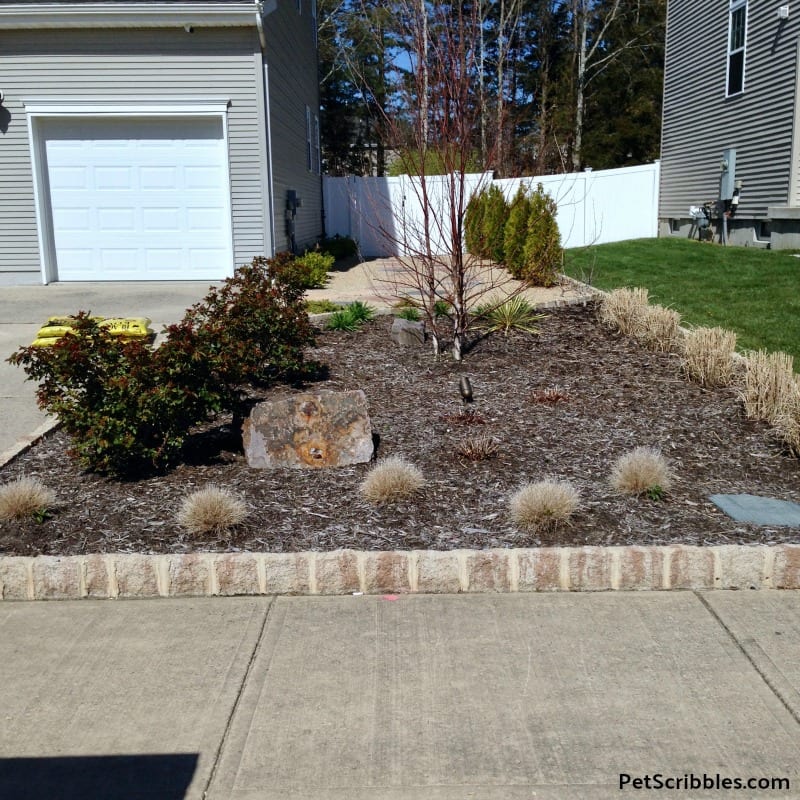
You can see in the image above how the black mulch that was originally applied had faded, over approximately a 1.5 year period. (I’ll refer back to this image later to show you how nice this bed looks today.)
How to improve garden soil organically
We did this project in the early Spring, but anytime is a good time if you want to improve garden soil quality.
Our plants have been happy and thriving ever since, so I’m sharing our easy soil improvement recipe with you:
- Rake up the old mulch
- Add more soil to garden beds if needed
- Dump the composted cow manure into a wheelbarrow
- Add the Black Kow composted cow manure
- Add Holly Tone if needed
- Rake the manure into the garden soil
- Add mulch
Caution: Before you begin this project, remind yourself where any landscape lighting wires or sprinkler lines are, so you can avoid accidentally damaging them.
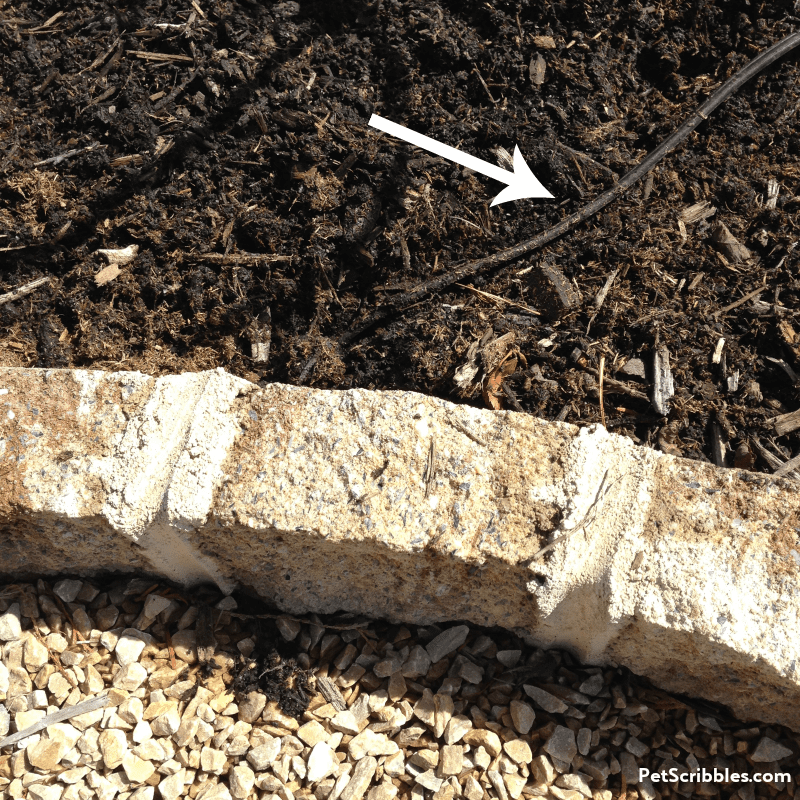
Rake up the old mulch
First we raked up all of the old mulch that the landscapers had used.
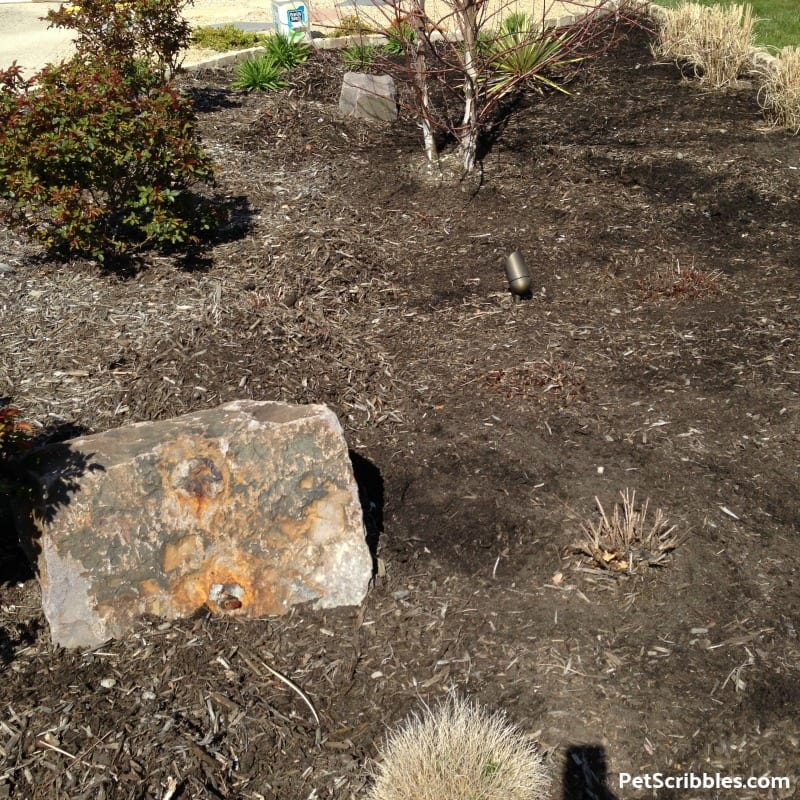
We worked in sections, and kept the old mulch in piles.
Helpful tip: Don’t throw away the old mulch. Rake it back into your garden soil instead, as it will decompose and help improve your soil as it breaks down.
Once you’ve mixed in all your ingredients — which are explained in the upcoming steps — you can mix the old mulch back into the newly improved garden soil, before you top off the garden beds with new mulch.
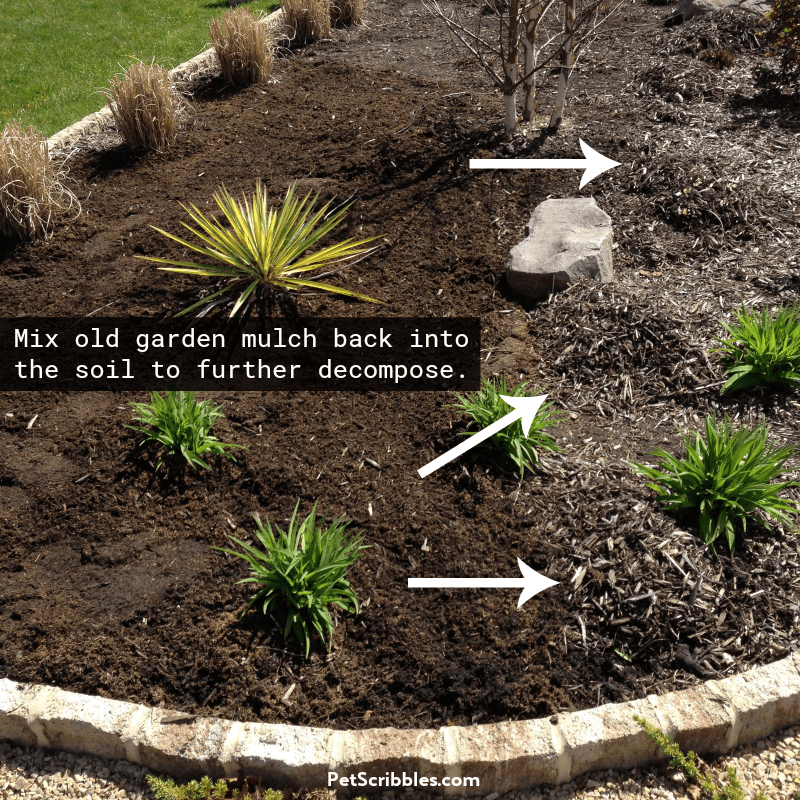
Add more soil to the garden beds if needed
This step is somewhat optional, based on what kind of soil you have underneath your mulch.
When our landscaping was done the previous Fall, “new” garden soil was put down — however, it wasn’t great nor was it evenly added into the beds.
So, we added fresh garden soil where needed, gently raking it into the existing soil.
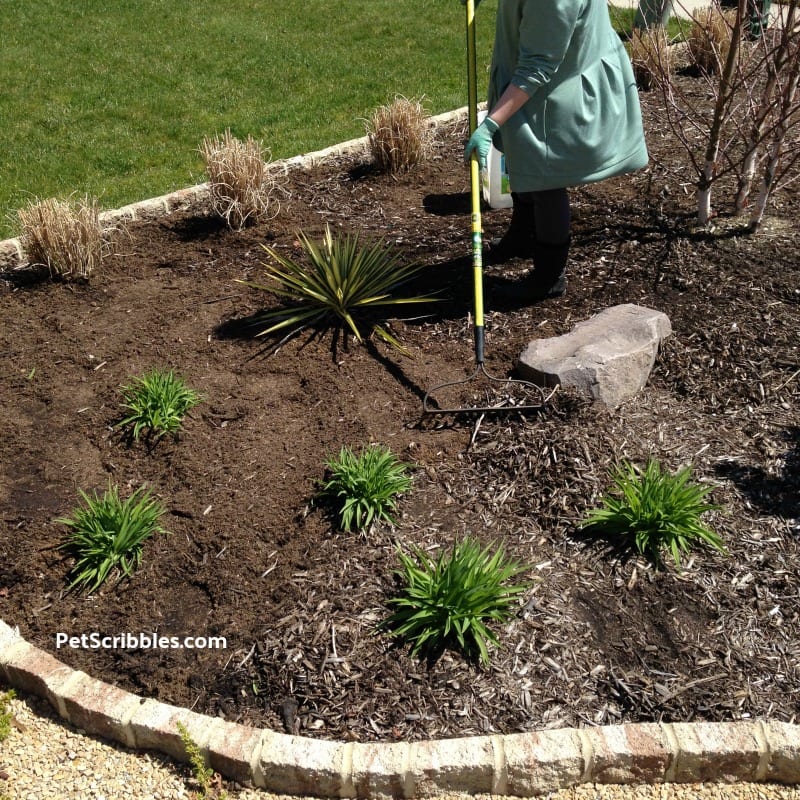
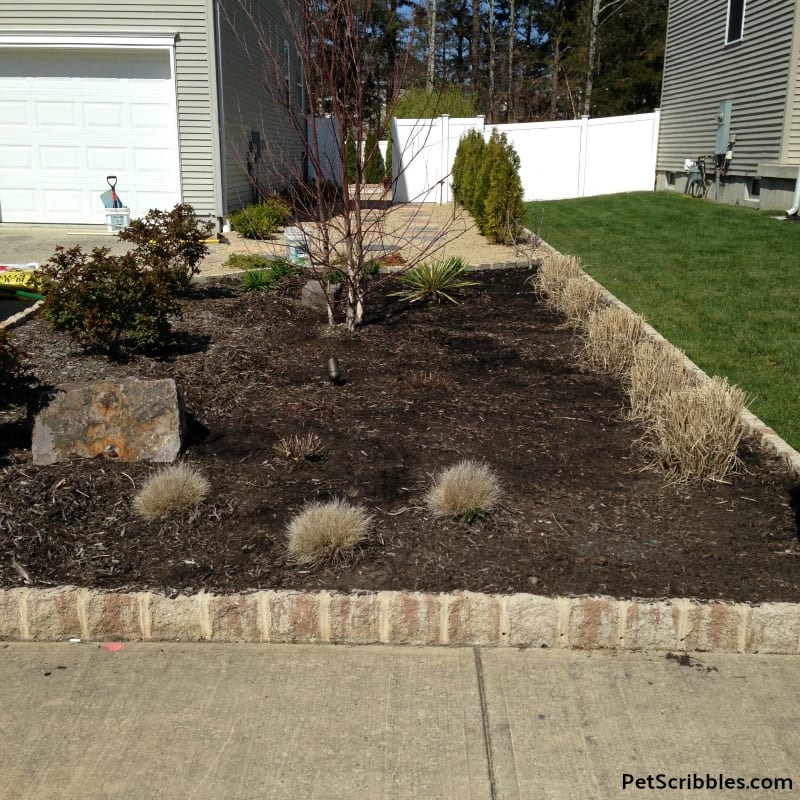
Dump the composted cow manure into a wheelbarrow
First, we dumped each 50-pound bag into our wheelbarrow, to make it easier on ourselves, versus lugging those bags all over the place. (If you’re purchasing smaller bags, you might be fine just spreading the cow manure compost directly from the bags.)
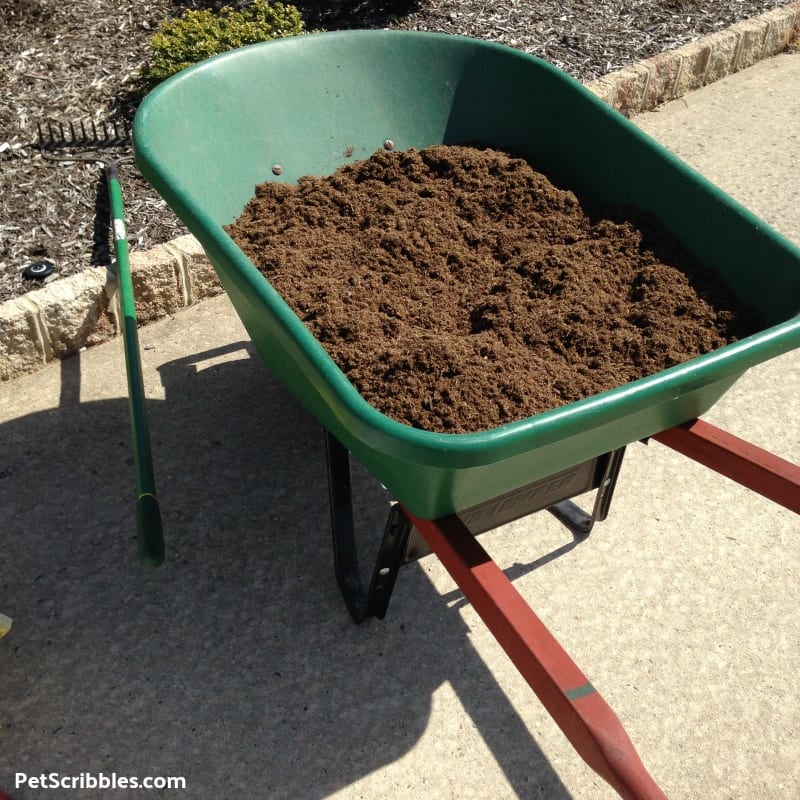
Mix in some Holly Tone if needed
We mixed Espoma Holly Tone slow-release organic fertilizer into the composted manure while it was in the wheelbarrow. Doing so made it possible for us to fertilize our acid-loving plants at the same time as we spread the manure. (The majority of our plants were acid-loving, while our soil was not.)
Add the Black Kow composted cow manure to the garden
Next we used shovels and buckets to scoop up the composted cow manure and put it on top of the garden soil.
We also spread the manure around with our gloved hands and a hand rake cultivator, making sure to keep at least a one-inch layer of manure on top of the garden soil.
Rake the composted cow manure into the garden soil
Next, we gently raked the composted cow manure into the garden soil.
You want to mix the soil and manure together.
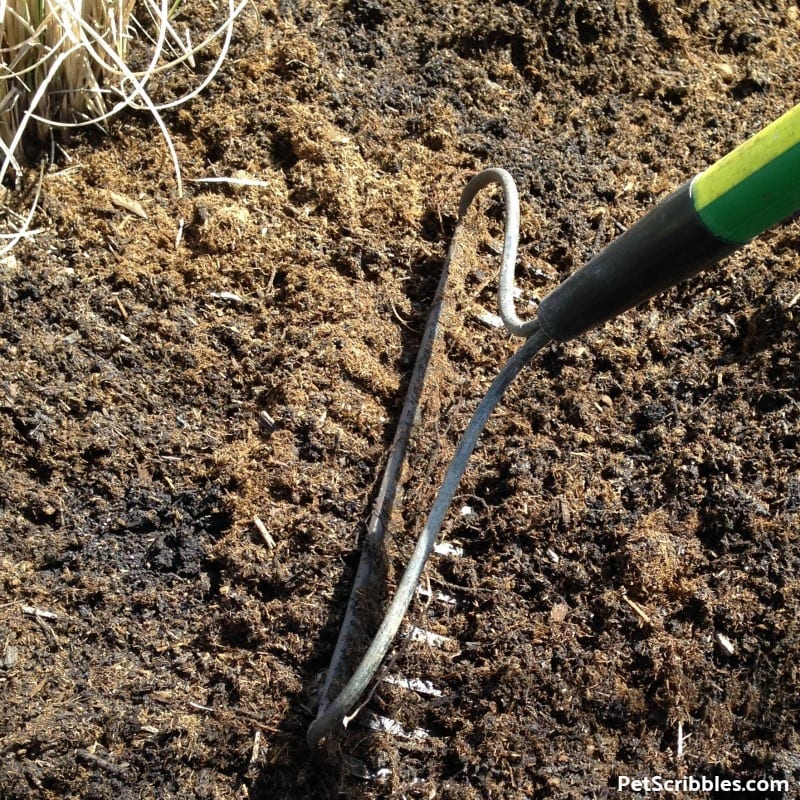
In some areas, such as near the edges of your garden beds as well as around smaller plants, it might be easier to use the hand rake cultivator to mix the soil and manure together. (Less chance of creating a mess outside the beds as well as less chance of damaging those plants too.)
Yes, raking the mulch into the soil was quite a job, but we did it! Obviously, as a two-person job this will go twice as fast — at least — versus doing this by yourself.
Add mulch to your garden
Finally, add the mulch of your choice to your garden beds.
We did this final step the next day, mainly because we scheduled our bulk mulch delivery for that morning. This ended up being a smart idea to break up the entire project into two days because we had so much ground to literally cover. Your own mileage may vary!
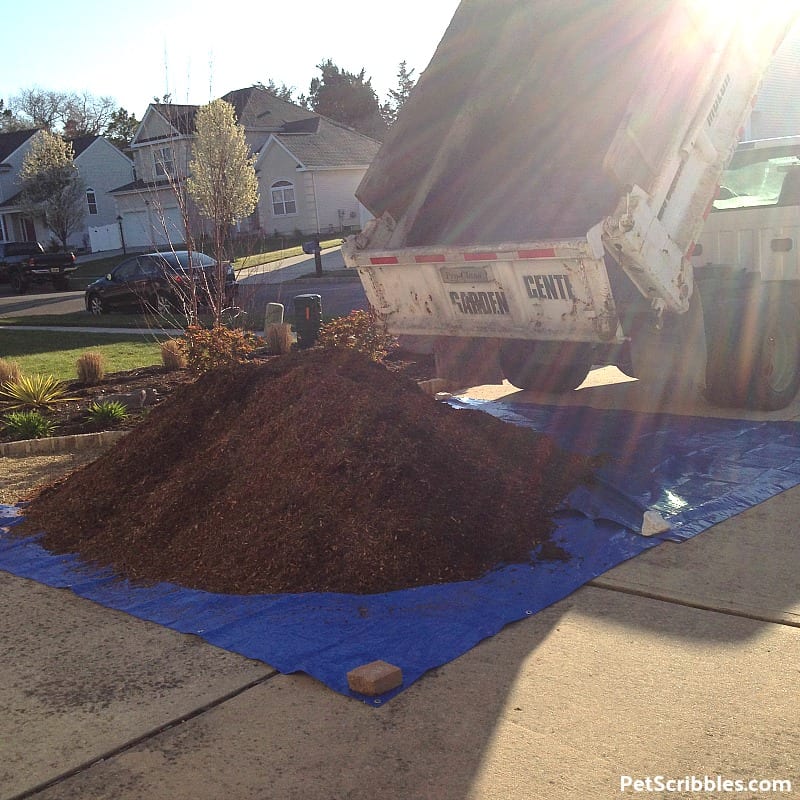
We got a delivery of playground mulch — our favorite kind of mulch — from a local garden center. For us, it was much cheaper than purchasing individual bags of mulch, since we needed such a large amount.
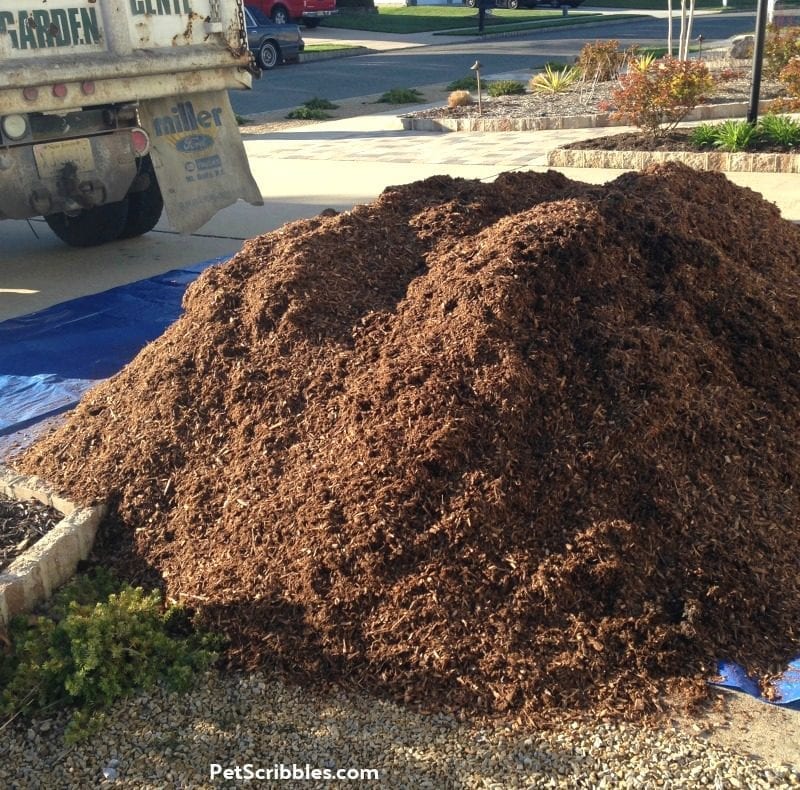
Adding mulch is almost exactly the same as adding in the composted cow manure, except you’re not mixing the mulch into the soil.
First we loaded up the wheelbarrow with some mulch, then used shovels and buckets to add the mulch into the beds, being careful around our trees, shrubs and plants.
Next we used our gloved hands and rakes (mentioned earlier in this post) to move the mulch around and spread it evenly.
Once we finished, the garden beds looked much better, even though it was still early Spring.
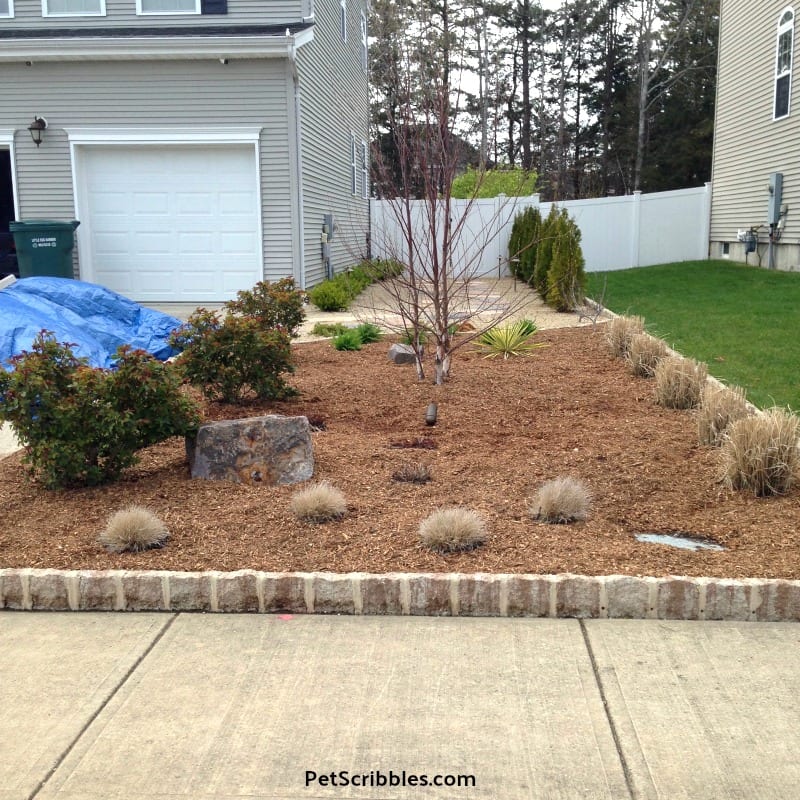
The mulch was a neutral shade that, as a background color, could feature all the colorful flowers and plants to come. Underneath the mulch is a healthier soil that will continue to improve over time.
Before and After Photos
Lamp Post Garden Bed
BEFORE: This was the newly constructed (and planted) lamp post garden bed . . .
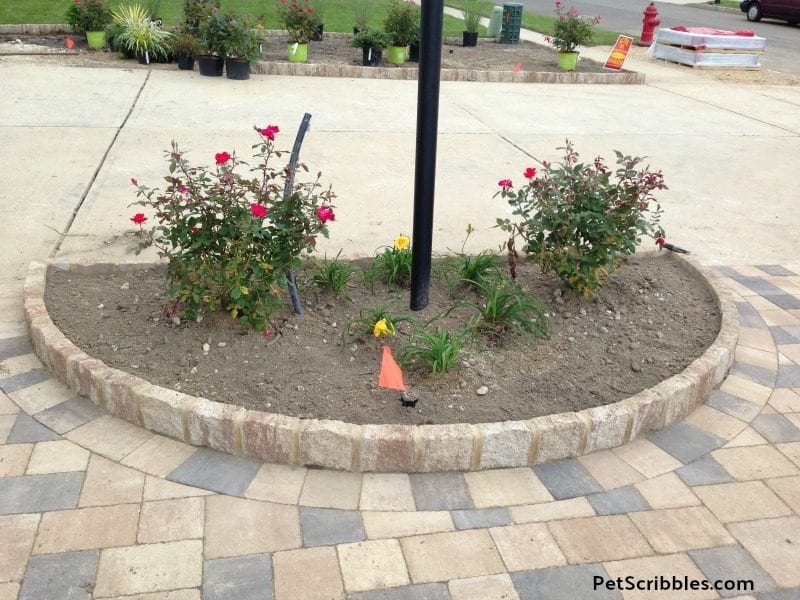
AFTER: Here is the same lamp post bed with the new mulch (and better soil underneath) . . .
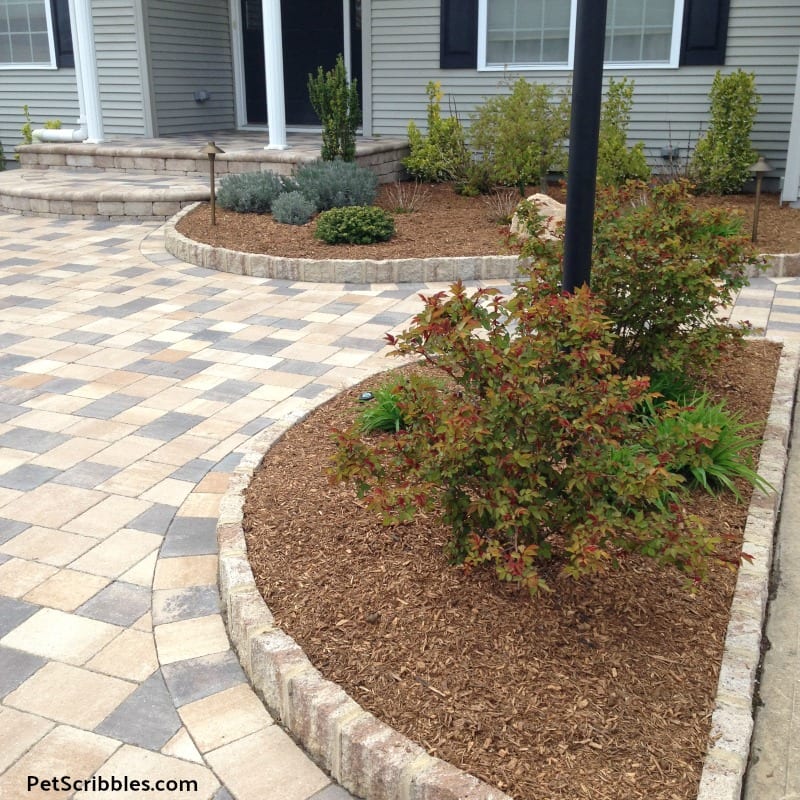
Front Entrance Garden Bed
BEFORE: One of our front entrance garden beds that you saw earlier in this post . . .

AFTER: This is the same bed after our manure and mulch weekend . . .

TODAY: Here is the same bed 3 years later, early June 2019 . . .
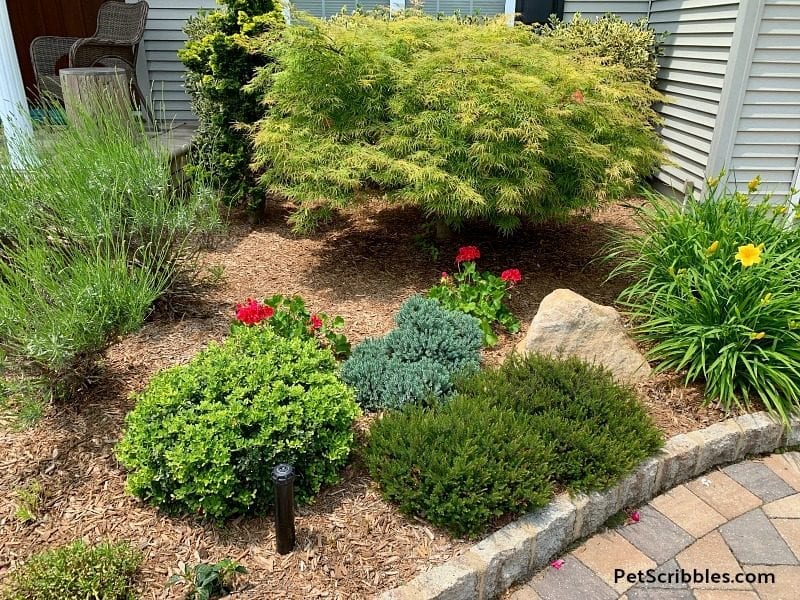
Large Garden Bed, next to driveway
BEFORE: This is the photo I showed you earlier, of the garden bed before we did anything . . .

AFTER: The same garden bed with lots of composted cow manure, organic slow-release fertilizer and fresh mulch . . .

TODAY: Again, this is a current view of the same bed in early June 2019, three years later . . .

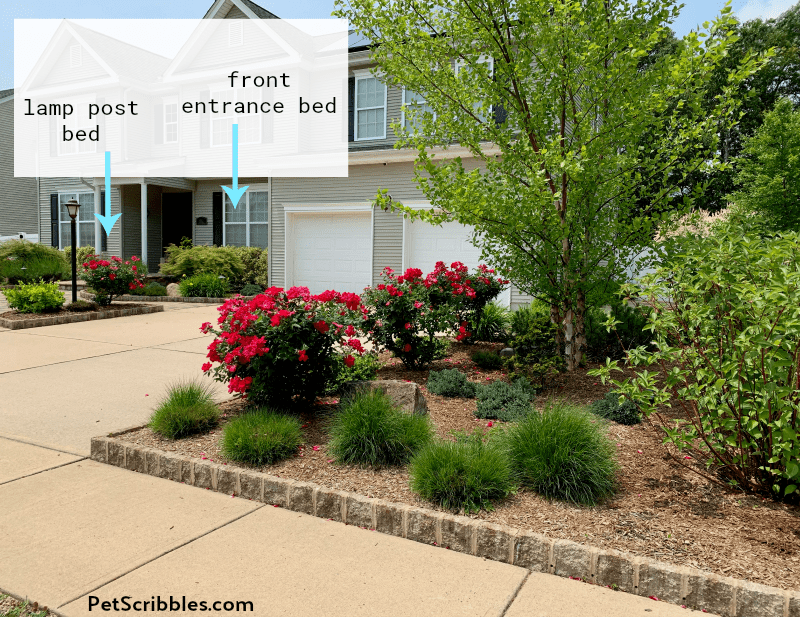
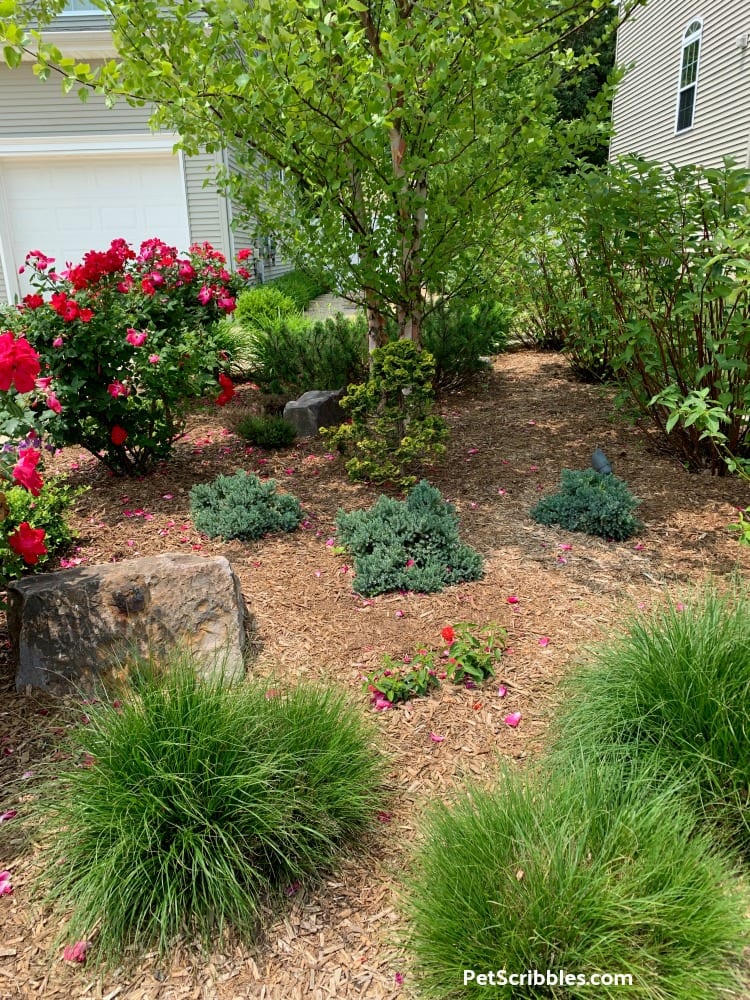
Easy Step for Soil Improvement Every Year
To maintain our soil, we add some Black Kow composted cow manure every year, just sprinkling it around our existing plants and shrubs and working it into the mulch or existing soil. We don’t need to use much at all, but we can tell that it definitely helps. You can use it as a top dressing for your garden too.
Our soil has really improved over the years, not just from the addition of composted cow manure, but also from the mulch breaking down over time and all the lovely earth worms and dead leaves and other fun things that become a part of the garden.
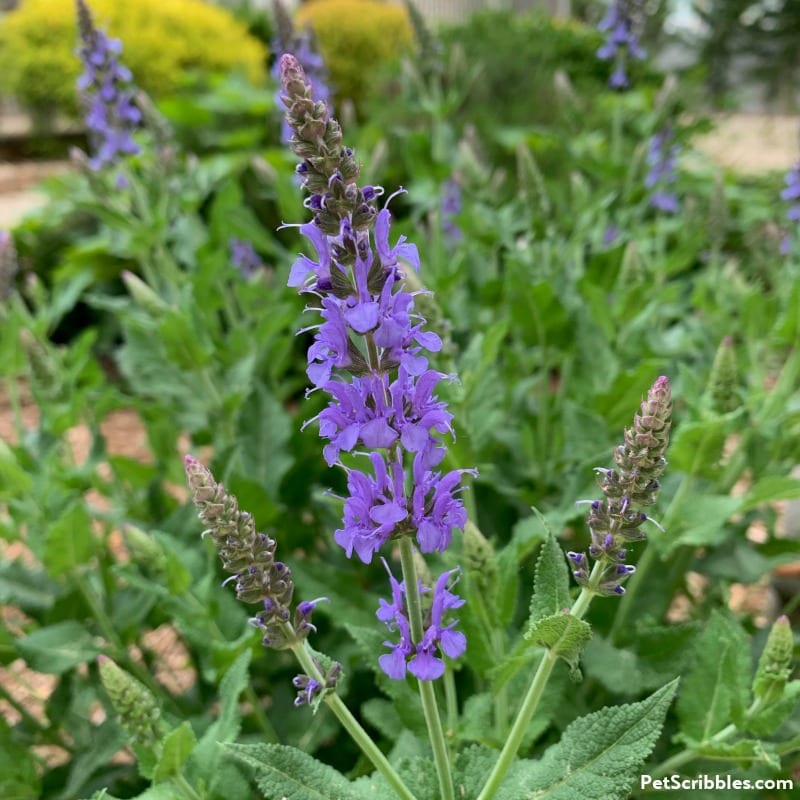
We are beginning to plan for new garden beds in our backyard, and will be using this same process to insure our plants, shrubs, trees and flowers are thriving for years to come.
Happy gardening!

I love how you explained every step in detail. Thank you. I have a lot of clay dirt and I’m hoping this will improve our soil.
Thanks so much for saying this — as that’s always my goal: explain steps in detail and try to keep those steps clear and easy-to-follow too. I really appreciate your comment, and I hope this helps your clay soil!
What a great article. Thank you so much for the detail. While I am no amateur I really wanted this year to improve on things. We have used cow manure right along but the extra tips very helpful. Happy gardening!
You’re welcome Molly! I’m happy the article helped, and I appreciate your feedback very much! Happy gardening to you as well!
This s an awesome article! The right amount of explanation, before and after pics perfect!
Now I know exactly how to use black cow to enrich my gardens, fruit trees, and new tree plantings I’m doing this spring. Thanks so very much!
You’re so welcome Terry! And thank YOU for your feedback — I really appreciate it! Happy gardening!